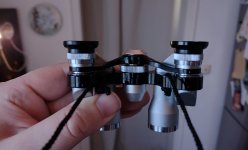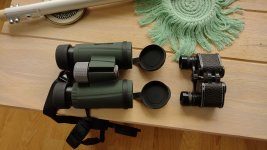looksharp65
Well-known member

Recently I watched a YT video from one of all the countless cycling channels mostly promoting new tech and industral trends.
The scope of this particular video, however, was the exact opposite - under-biking. The author revisited the '90s when the MTB sport was young and largely underdeveloped.
He mentioned the most notable differences in frame geometry, tyre width and pressure, and the absence of suspension. So he went on by cycling a path he'd known for long, and told about the shortcomings and the acceptable traits of the old bike. Nothing unexpected there.
But he recommended anyone willing to sacrifice a few bucks for some great fun to buy a bike that's a couple of decades or so. It's cheap, it's educating and it's fun.
I'd like to add that a few sessions with old stuff rarely feels very handicapping, but once you're back with your state-of-the-art equipment, it feels really amazing.
Obviously, I have optics on my mind when telling about this video. And I'm lucky to own a retro set consisting of an old but well-preserved Meopta 6x30 porro with antireflective coatings and a Kowa TS-1. They share a few common characteristics, namely lower magnification, smaller AFOV, a yellow colour representation but also very decent sharpness. The little Meopta is incredibly sharp in the center, has a lightning-fast and easy focuser and it's very lightweight. The TS-1 is identical to what my father used from about 1978, and it was decent by yesteryear's standards, but he used a Jenoptem 8x30.
I haven't practised under-binning in the field yet, maybe because I own a decent collection of fairly modern optics and value my leisure time. It would be devastating to miss an ID because of under-binning, while at the same time I feel it might be a cool thing to do for the abovemenioned reasons.
It would also be fun to arrange an under-binning rallye with strict equipment rules with regard to minimum age and maximum magnification.
If I went out to the local reserve with this kit, many fellow local birders would recognise me as that binocular nerd, and just shrug their shoulders. It might be interesting, though, to observe the barely noticeable reactions (and then again some maybe not so discreet) from birders coming in from other places.
So how do you do? Are your old binoculars only curiosities or do you take them to the field? I'm now talking about single-coated optics, mainly porros but also non-phasecoated roofs, and scopes that perform best at 20x but can do 25x with a stretch. Obviously, if there's other vintage optics you use, by all means let us know.
//L
The scope of this particular video, however, was the exact opposite - under-biking. The author revisited the '90s when the MTB sport was young and largely underdeveloped.
He mentioned the most notable differences in frame geometry, tyre width and pressure, and the absence of suspension. So he went on by cycling a path he'd known for long, and told about the shortcomings and the acceptable traits of the old bike. Nothing unexpected there.
But he recommended anyone willing to sacrifice a few bucks for some great fun to buy a bike that's a couple of decades or so. It's cheap, it's educating and it's fun.
I'd like to add that a few sessions with old stuff rarely feels very handicapping, but once you're back with your state-of-the-art equipment, it feels really amazing.
Obviously, I have optics on my mind when telling about this video. And I'm lucky to own a retro set consisting of an old but well-preserved Meopta 6x30 porro with antireflective coatings and a Kowa TS-1. They share a few common characteristics, namely lower magnification, smaller AFOV, a yellow colour representation but also very decent sharpness. The little Meopta is incredibly sharp in the center, has a lightning-fast and easy focuser and it's very lightweight. The TS-1 is identical to what my father used from about 1978, and it was decent by yesteryear's standards, but he used a Jenoptem 8x30.
I haven't practised under-binning in the field yet, maybe because I own a decent collection of fairly modern optics and value my leisure time. It would be devastating to miss an ID because of under-binning, while at the same time I feel it might be a cool thing to do for the abovemenioned reasons.
It would also be fun to arrange an under-binning rallye with strict equipment rules with regard to minimum age and maximum magnification.
If I went out to the local reserve with this kit, many fellow local birders would recognise me as that binocular nerd, and just shrug their shoulders. It might be interesting, though, to observe the barely noticeable reactions (and then again some maybe not so discreet) from birders coming in from other places.
So how do you do? Are your old binoculars only curiosities or do you take them to the field? I'm now talking about single-coated optics, mainly porros but also non-phasecoated roofs, and scopes that perform best at 20x but can do 25x with a stretch. Obviously, if there's other vintage optics you use, by all means let us know.
//L












